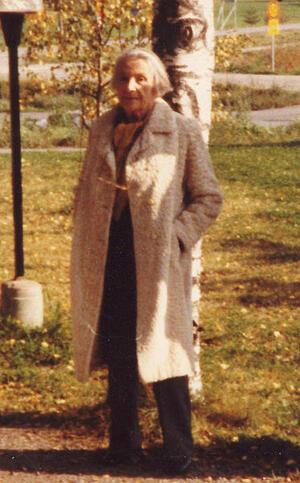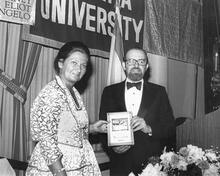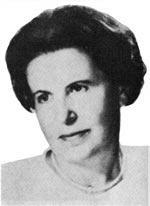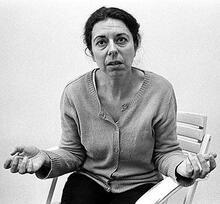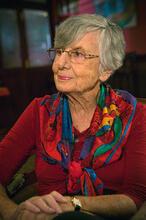Nathalie Sarraute
Born in Russia, Nathalie Sarraute graduated from the Sorbonne in 1920, and studied at Oxford University and the University of Berlin. In 1925, she was awarded a law degree by the Faculty of Law in Paris, where she practiced law until 1941, when she was no longer allowed to because of the German occupation of France. During World War II, she joined a resistance group formed by Jean-Paul Sartre and posed as the governess of her three daughters to hide her Jewish identity. Disliking categorization, Sarraute refused to be described as a “woman writer” or “Jewish writer.” Her many novels and plays are characterized by an “inwardness” and an unusual lack of characters, names, and plot. At 83, Sarautte published her first bestseller, Childhood (1983), and she received many awards and accolades for her work.
Early Life
Nathalie (Tcherniak) Sarraute was born in Ivanovo, Russia, on July 18, 1900, into an assimilated family of intellectual Jews. Her father, Ilyanova Tcherniak, was a doctor of sciences and a chemical engineer. Her mother, Pauline Chatounovski, published novels under the pseudonym of Vikhrovski. After her parents divorced in 1902, her early childhood was divided between her mother and father (both of whom remarried), and between France and Russia; from the age of eight, she lived in Paris with her father, whose political opinions had made it difficult for him to remain in Russia.
On completing her schooling at the Lycée Fénelon, Sarraute received a degree in English from the Sorbonne (1920) and then spent a year studying history at Oxford University (1921) and six months studying philosophy and sociology at the University of Berlin (1921–1922). In 1925, she was awarded a law degree by the Faculty of Law in Paris, where she had begun studies in 1922 and had met Raymond Sarraute (d. 1985). The couple married in 1925 and had three daughters, Claude, Anne, and Dominique. From 1926 to 1941 she was a member of the French Bar. During the German occupation of France, Sarraute joined a resistance group formed by Jean-Paul Sartre and others and spent long periods using false papers. In 1960, she was a signatory on the Manifesto of the 121, protesting against French state policy towards Algeria. When asked about her political stance, Sarraute described herself as having political commitments as a citizen, but not as a writer.
A Russian Jew by birth, French by education a,nd European by culture, Sarraute was always intensely aware of and resistant to the reductive powers of categorizing language: she refused to be described as a “woman writer,” and would equally refuse the label “Jewish writer.” Growing up in Paris in the highly cultured milieu of her free-thinking father, Sarraute never felt any sense of difference in status between men and women, and Jewishness was never an issue.
Life Under German Occupation
While Jewishness in itself was not a salient feature of Sarraute’s life, it became a very serious issue upon the German occupation of France. As a Jew, she was no longer allowed to practice at the Bar, and in 1942, when the yellow star was imposed, she collected hers but decided not to wear it. Living in the provinces under a false name and posing as the governess of her three daughters, she was denounced by a local baker but escaped just in time. The German occupation and the hideous revelations of the Holocaust had a profound impact on Sarraute, reinforcing a horror of which she had had early intimations, growing up among Russian emigrés who had experienced the czarist regime and having been appalled by the atmosphere of terror and oppression she encountered on her visit to Russia in 1935. The totalitarian world of censorship, fear, prisons, and secret police haunts Sarraute’s work, despite the fact that history as such has no place within it. Her work is focused not on external but on internal events.
Sarraute was vividly aware of Jewish suffering. Her husband, Raymond, co-edited an anthology on Jewish experience of the Occupation. In her work she deals neither with the matter of being Jewish, nor with antisemitism, but the thrust of all her work is against every sort of racism, terrorism, and tyranny. At the end of an essay of 1947 Sarraute makes one explicit and passionate reference to the infamies of Nazism, with an explosion of rage, contempt and something that goes beyond all these emotions: “a huge blank stupefaction, a definitive and total bafflement.”
Analysis of Sarraute’s Writing
Sarraute’s entire oeuvre is dedicated to the exploration of minute, ephemeral movements of feeling at the very limits of consciousness. These she called “tropisms,” a term that provided the title of her first book of short sketches or prose poems. In the works that followed, Sarraute showed the tropisms at work in the wider scope of the novel form, creating slow-motion close-ups that dramatize and enormously enlarge—often with comic effect—the virtual dramas latent in ephemeral flickers of feeling. In her pursuit of the tropisms, characterization and conventional plot were discarded, in defiance of the most hallowed traditions of the novel, traditions she explicitly challenged in the seminal critical essays of The Age of Suspicion. This radical questioning of the novel form made her a major player in the “new novel” movement which, in the 1950s, allied her with such very different writers as Alain Robbe-Grillet, Michel Butor and Claude Simon in a common rebellion against what were felt to be the outdated constraints of traditional realism.
For Sarraute, personality is a fundamentally artificial invention, and the very notion of “character” is called into question. The beings in her novels remain undefined and nameless. The Planetarium, exceptionally, has named “characters,” but they are shown to be artificial social constructs—false planets in the false sky of the Planetarium. Names, and even common nouns such as those indicating family relationships or professions, are seen as imprisoning, freezing people into fixed roles. Sarraute shows language to be a powerful weapon; not merely names and nouns, but even pronouns can have petrifying effects: if “we” produces a cosy togetherness for “us,” it chills the excluded, while a plural “you” can seem to convict and irrevocably sentence. The milieu Sarraute presents throughout her work is one with which she is familiar—the world of the Parisian bourgeois intellectual—though her interest lies not in any specific social group, but in the tropismic subsurface, the level at which we are all, in Sarraute’s view, alike.
Sarraute’s natural mode is hesitancy, and her mood interrogative; her refusal of definition and closure is everywhere evident—in the frequent trails of dots that bestrew her pages, the avoidance of social or historical context, the rejection of characterization and the refusal of all certainty. Art itself, literary values, aesthetic values of every kind, are all put to the question—whether in The Golden Fruits, which recounts with a great deal of wit and perspicacity the way a novel soars and plummets in critical estimation, or in Between Life and Death, which takes the reader into the very quick of literary composition with its anguish and doubts. Do You Hear Them?, unfolding the dramas latent in a father’s reaction to the laughter of his children, continues the questioning, weighing the civilized (conformist? moribund?) culture of age against the barbarous (original? vital?) culture of youth. Even when dealing with complex or abstract subjects, Sarraute’s writing remains securely anchored in the most inward realities of human interactions.
Later Writing, Plays, and Awards
Throughout Sarraute’s work, there is a growing insistence on the interpersonal—a view of the self not as an individual and separate entity confronting the world of others, but as the habitation of a multitude of virtual selves. In Childhood, Sarraute uncovers the tropisms underlying various fragments of her own childhood memories, creating, in the process, at the age of eighty-five, her first bestseller. In You Don’t Love Yourself, every personal pronoun—and especially the first-person singular—becomes a question-mark, while in Sarraute’s penultimate book, Here, the “I” is replaced by a simple location—the “here” of the title.
The very inwardness of Sarraute’s writing would seem to be inimical to the theatre, but in the 1960s she was persuaded to provide a radio play, Silence, for Radio Stuttgart. Three other radio plays followed—all later successfully produced on stage. It Is There was the first to be actually written for the stage and this was followed by the best-known of her plays, For No Good Reason. In the plays, as in Sarraute’s other works, characters are virtually nonexistent; names are rare, and plot is minimal. Drama, however, is sustained, as the multifarious impulses and conflicts of the subconversation become the spoken dialogue, in a turning inside out of the normal process.
Sarraute’s strength lies above all in her rich ironic humor and her poetic ability to translate sensation into language, articulating the tropisms through images and rhythm, not defining nor analyzing, but making her readers experience them for themselves. Her awards include the Prix International de Littérature (1964); the Grand Prix National des Lettres (1982); and the Grand Prix de la Société des auteurs et compositeurs dramatiques (SACD, 1996). In 1996 Sarraute had the rare accolade of having her works published during her lifetime in the classic Pléiade collection. Her production of a further (well-named!) volume, Open, one year after the publication of her Complete Works, rather splendidly underlined her characteristic refusal of closure.
Nathalie Sarraute died in Paris on October 19, 1999.
SELECTED WORKS BY NATHALIE SARRAUTE
Fiction
Tropismes (1939, revised 1957, as Tropisms, with The Age of Suspicion, translated by Maria Jolas, 1963).
Portrait d’un inconnu (1948, revised 1956, as Portrait of a Man Unknown, translated by Maria Jolas, 1958).
Martereau (1953, as Martereau, a Novel, translated by Maria Jolas, 1959).
Le Planétarium (1959, as The Planetarium, translated by Maria Jolas, 1960).
Les Fruits d’or (1963, as The Golden Fruits, translated by Maria Jolas, 1964).
Entre la vie et la mort (1968, as Between Life and Death, translated by Maria Jolas, 1969).
Vous les entendez? (1972, as Do You Hear Them?, translated by Maria Jolas, 1973).
“disent les imbeciles” (1976, as “fools say,” translated by Maria Jolas, 1977).
L’Usage de la parole (1980, as The Use of Speech, translated by Barbara Wright with the author, 1980).
Enfance (1983, as Childhood, translated by Barbara Wright with the author, 1984).
Tu ne t’aimes pas (1989, as You Don’t Love Yourself: A Novel, translated by Barbara Wright with the author, 1990).
Ici (1995, as Here: A Novel, translated by Barbara Wright with the author, 1997).
Ouvrez [Open], 1997.
Plays
Le Silence, suivi de Le Mensonge (1967, as Silence, and The Lie, translated by Maria Jolas, 1969).
Isma (1970, as Izzum, translated by Maria Jolas, in Collected Plays, 1980).
C’est beau (1975, as It’s Beautiful, translated by Maria Jolas, in Collected Plays, 1980).
Elle est là (1978, translated as It Is There, translated by Maria Jolas, in Collected Plays, 1980).
Théâtre (includes Elle est là, C’est beau, Isma, Le Mensonge, Le Silence) (1978).
Collected Plays (includes It Is There, It’s Beautiful, Izzum, The Lie, Silence), translated by Maria Jolas and Barbara Wright, 1980.
Pour un oui ou pour un non (1982, as For No Good Reason (1985).
Other
L’Ère du soupçon (1956, as The Age of Suspicion: Essays on the Novel, translated by Maria Jolas, 1963, with Tropisms, 1963).
Paul Valéry et I’Enfant d’Éléphant.
Flaubert le précurseur [Paul Valéry and the Elephant’s Child, Flaubert the Forerunner] (1986).
Nathalie Sarraute, qui êtes-vous? Conversations avec Simone Benmussa [Nathalie Sarraute, Who Are You? Conversations with Simone Benmussa] (1987).
Oeuvres completes [Complete Works] (1996).
Angrémy, Annie (ed.). Nathalie Sarraute: portrait d’un écrivain (exhibition catalog). Paris: 1995.
Asso, Françoise. Nathalie Sarraute: une écriture de l’effraction. Paris: 1995.
Bell, Sheila M. Nathalie Sarraute: A Bibliography. London: 1982.
Bell, Sheila M. “The Conjuror’s Hat: Sarraute Criticism since 1980.” Romance Studies 23 (Spring 1994).
Besser, Gretchen Rous. Nathalie Sarraute. Boston: 1979.
Boué, Rachel. Nathalie Sarraute: La Sensation en quête de parole. Paris: 1997.
Clayton, Alan J. Nathalie Sarraute; ou, Le tremblement de l’écriture. Paris: 1989.
Foutrier, Pascale (ed.). Éthiques du Tropisme. Paris: 1999.
Gjerden, Jorunn Svenssen. Ethique et esthétique dans l'œuvre de Nathalie Sarraute: Le paradoxe du sujet, Paris: 2007.
Gleize, J., and A. Leoni. Nathalie Sarraute, un écrivain dans le siècle. Aix-en-Provence: 2000.
Jefferson, Ann. The Nouveau Roman and the Poetics of Fiction. Cambridge: 1980.
Jefferson, Ann. Nathalie Sarraute: Fiction and Theory. Cambridge and New York: 2000.
Jefferson, Ann. Nathalie Sarraute: A Life Between. Princeton: Princeton University Press, 2021.
Minogue, Valerie. Nathalie Sarraute and the War of the Words: A Study of Five Novels. Edinburgh: 1981.
O’Beirne, Emer. Reading Nathalie Sarraute: Dialogue and Distance. Oxford: 1999.
Pierrot, Jean. Nathalie Sarraute. Paris: 1990.
Raffy, Sabine (ed.). Autour de Nathalie Sarraute, Annales Littéraires de 1’Université de Besançon. Paris: 1995.
Rykner, Arnaud. Nathalie Sarraute. Paris: 1991.
Tadié, Jean-Yves. Introduction to Nathalie Sarraute, Oeuvres complètes. Paris: 1996; with Notices [critical commentaries] by A. Jefferson, V. Minogue and A. Rykner.
Tobiassen, Elin Beate. Vers l'instant, Lecture de 'Portrait d'un inconnu' de Nathalie Sarraute. Bern: 2003.
Special Issues
L’Arc 95 (1984).
Critique (January–February 2000).
Digraphe 32 (March 1984).
L’Esprit créateur 36/2 (Summer 1996).
Magazine littéraire 196 (June 1983).
“Nathalie Sarraute: Portrait d’un inconnu et tu ne t’aimes pas.” Roman 20–50 25 (June 1998).
Revue des Sciences Humaines 217 (1990–1991).
This article from: Jewish Writers of the Twentieth Century. Editor: Sorrel Kerbel. Copyright © 2003. Reproduced by permission of Routledge/Taylor and Francis Books, Inc.

